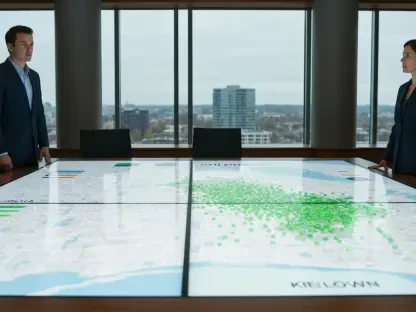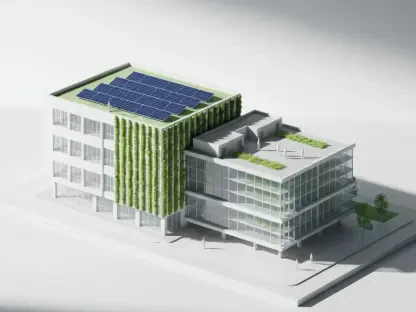Around the world, cities are experiencing a renaissance in urban planning, driven by the dual imperatives of sustainability and modernization. As urban areas grow and evolve, the focus is increasingly on integrating green technologies and sustainable architectural practices. This shift represents a broader movement toward intelligent urban design meant to address the intensifying challenges such as climate change, rising urban populations, and a heightened demand for resources. Technological innovations and responsible investment strategies are leading the way in transforming urban landscapes into dynamic, ecologically friendly spaces that also cater to the comfort and well-being of their inhabitants. These transformations are fundamental not only for mitigating environmental impacts but also for creating vibrant, resilient cities ready to meet future demands.
Innovation in Building Design and Sustainability
C376 Amendment and Green Factor Tool in Melbourne
Melbourne stands at the forefront of urban sustainability with its endorsement of the C376 Amendment, widely recognized as a sustainable building design initiative. This amendment introduces stringent standards intended to elevate the city’s building practices to align with best practice sustainability standards worldwide. At its core, the initiative aims to answer an urgent need for reduced urban heat and increased biodiversity, supported by focusing on urban greening and ecological design elements in architectural planning. A significant feature of this initiative is the Green Factor Tool, collaboratively developed to measure and enhance new building designs’ urban greening capabilities. By providing an accessible and expert-endorsed resource, this tool helps architects and planners incorporate ecological considerations right from the design stage.
The implementation of the C376 Amendment and its associated tools reflects a growing movement in the urban planning sector, emphasizing the importance of integrating innovative green technologies into standard construction protocols. The commitment to these changes signals a significant shift in Melbourne’s urban development strategies, prioritizing sustainability and environmental responsibility alongside economic growth. By combining cutting-edge technologies with strategic planning, the city aims to reduce its carbon footprint while enhancing its living spaces, making it a compelling model for other metropolitan areas worldwide. The focus on both ecological and socioeconomic factors ensures that Melbourne’s approach is holistic, promoting a sustainable urban ecosystem that benefits all stakeholders.
Cool Roof Initiative in American Cities
Parallel to developments in Melbourne, American cities like Atlanta are embracing new technologies such as “cool roofs” to combat urban heat and improve sustainability. These roofs are designed to reflect more sunlight and absorb less heat than standard roofing materials, significantly reducing energy consumption needed for cooling buildings and extending the roofs’ lifespan. The adoption of cool roofs is part of a broader strategy aimed at mitigating the effects of urban heat islands, especially in densely populated urban centers where traditional construction methods have contributed to rising temperatures. By leveraging reflective technologies, cities can enhance environmental sustainability while also achieving considerable energy savings.
The implementation of cool roofs indicates a burgeoning trend across many American cities to embrace reflection-based technologies in urban planning. This initiative does not merely address environmental concerns but also offers economic benefits by reducing energy costs and slowing infrastructure wear and tear. The strategic adoption of these technologies reinforces the necessity for cities to innovate continuously to meet modern challenges. As cities increasingly prioritize green building standards and renewable technologies, cool roofs represent a pragmatic, cost-effective solution facilitating the transition toward sustainable urban environments. They exemplify how simple yet effective changes can lead to substantial long-term benefits for both urban dwellers and the planet.
Property Investment and Political Developments
Cbus Property’s Investment in Melbourne
The real estate sector in Melbourne is undergoing a transformative period, spurred by robust property investments that are reshaping the city’s landscape. Cbus Property’s recent commitment of $400 million to a new residential project in Richmond exemplifies a broader confidence in the city’s growth potential. This sizable investment is set to establish a significant residential development that promises to contribute positively to the urban environment while delivering on aesthetic and lifestyle aspirations. By focusing on creating a micro-village ambiance, the project prioritizes communal elements and a seamless integration with the local environment, blending urban living with sustainable practices.
Cbus Property’s initiative showcases a proactive approach to urban development, where economic growth does not come at the expense of environmental responsibility. The project, which represents the company’s 25th major venture in Melbourne, demonstrates both a strategic commitment to the city’s future and a responsive adaptation to current market conditions and environmental standards. The state government’s decision to fast-track planning processes further illustrates a supportive framework aimed at fostering innovation in the real estate sector. With architecture led by SJB Architects, the development is expected to align with high standards of sustainability while simultaneously enhancing the quality of life for future residents.
Political Accountability in Australian Elections
In the political sphere, developments in electoral accountability are unfolding as newly elected officials navigate complex challenges. Nicolette Boele’s election to the federal parliament seat of Bradfield underscores the intricacies involved in modern political contests. Her narrow win, contested by the Liberal Party, highlights the fine margins that often characterize electoral outcomes. Pledging to return donations if legal proceedings validate her victory, Boele’s situation illustrates a deeper narrative of political candor and the pressures faced by contemporary politicians. This episode also emphasizes the collaborative nature of political campaigns, seen through her reliance on Climate 200 for legal support.
The unfolding dynamics of Boele’s electoral journey reflect broader concerns about transparency and ethical conduct in politics. It also underscores the high stakes involved, where even minor discrepancies can have significant ramifications. Her case points to a trend where political accountability and public trust are increasingly demanded by constituents. This trend is gaining traction across various political territories, driving candidates and elected officials to demonstrate greater integrity and honesty. The situation provides insights into the current political climate in Australia, which is characterized by heightened scrutiny and a drive toward greater electoral transparency.
Corporate and Institutional Responses to Climate Change
Corporate Strategies for a Net Zero Future
Corporations are stepping up their climate response strategies, with entities like the Australian Council of Superannuation Investors and the Australian Institute of Company Directors offering critical guidance for transitioning to net-zero emissions. Their newly introduced guide, “Governing for Net Zero,” serves as an essential tool for corporate directors and investors, outlining necessary steps and standards to achieve climate goals. The publication focuses on areas such as governance, risk management, and strategic planning, equipping businesses to navigate the intricacies of mandatory climate reporting and sustainable practices. This initiative represents an important move towards fostering a culture of responsibility and foresight amongst key industry leaders.
This proactive direction underscores the mounting imperative for businesses to actively participate in global efforts against climate change. Through this guide, corporations can align their operational frameworks with sustainability objectives, ensuring compliance with emerging regulatory requirements while also leveraging opportunities for growth. The inclusion of case studies and legal insights offers a grounded approach to sustainability, allowing corporations to tailor strategies that suit their unique contexts. In an era where consumers and investors are increasingly inclined towards sustainable practices, such strategic initiatives enhance corporate reputability and competitiveness in the global marketplace.
Expanding Sustainability Certifications
NABERS, a pioneer in environmental performance rating, is amplifying its impact by expanding access to sustainability certifications. By extending a 50 percent discount on certification fees to smaller buildings across all sectors, NABERS aims to democratize sustainability, making it more attainable for varied stakeholders. This move aligns with wider industry efforts to increase inclusivity and participation in sustainable practices. Effective from July, this policy change reflects NABERS’ commitment to encouraging more businesses and property owners to measure and improve their environmental performance, contributing to overall sustainability goals.
The strategic expansion of NABERS’ policy highlights an important shift towards broader participation in environmental accountability. By targeting smaller establishments, this initiative exemplifies an inclusive approach that recognizes the cumulative impact of smaller entities in the sustainability journey. Encouraging a wider array of participants, NABERS is facilitating a system where sustainable practices are embedded across the spectrum of building sizes and sectors. This shift is crucial in promoting environmental stewardship, enabling businesses of all scales to contribute meaningfully to the broader goals of environmental sustainability.
Adaptive Strategies in Urban and Organizational Development
Redevelopment of Historical Sites
The transformation of historical sites to meet contemporary urban needs is another area where innovative planning intersects with tradition. The St Andrew’s Anglican Church in Lane Cove serves as a prime example of this adaptive strategy, undergoing redevelopment to include residential apartments while preserving its historical essence. This initiative encapsulates the delicate balance between honoring cultural heritage and responding to modern residential needs. By transforming the church property into a functional urban space, the project reveals the potential of adaptive reuse in urban planning practices, ensuring that development aligns with community values and identity.
Such adaptive projects embody a creative approach to urban development, where cultural preservation is harmoniously integrated with modernization efforts. Undertaking these ventures requires sensitivity to historical significance as well as a forward-thinking vision that addresses current and future community demands. The redevelopment at Lane Cove illustrates a thoughtful engagement with heritage, achieving a blend of old and new that respects traditional values while adapting spaces to better serve the populace. These efforts are crucial in fostering communities that are both historically informed and dynamically responsive to changing needs.
Leadership Changes and Industry Dynamics
Melbourne leads urban sustainability with the C376 Amendment, a landmark sustainable building design initiative. This amendment sets rigorous standards to elevate the city’s building practices to meet global sustainability benchmarks. Central to this initiative is addressing urgent issues like reducing urban heat and boosting biodiversity. The strategy emphasizes urban greening and integrating ecological design elements in architecture. A key component is the Green Factor Tool, created to measure and improve urban greening in new building designs. As an accessible resource, this tool allows architects and planners to incorporate ecological aspects from the outset.
The implementation of the C376 Amendment, along with its innovative tools, reflects a growing trend in urban planning, stressing the integration of green technologies into regular construction methods. Melbourne’s commitment to these changes marks a shift in its urban development, prioritizing sustainability alongside economic growth. This approach reduces the city’s carbon footprint and enhances living spaces, setting a precedent for metropolitan areas globally. By addressing ecological and socioeconomic factors, Melbourne fosters a sustainable urban ecosystem benefiting all stakeholders.









